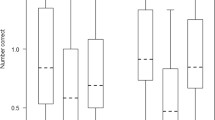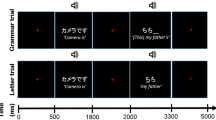Abstract
The interaction between working memory and language processing is widely discussed in cognitive research. However, those studies often explore the relationship between language comprehension and working memory (WM). The role of WM is rarely considered in language production, despite some evidence suggesting a relationship between the two cognitive systems. This study attempts to fill that gap by using a complex span task during language production. We make our predictions based on the reorganization of elementary functions neurocognitive model, a usage based theory about grammatical status, and language production models. In accordance with these theories, we expect an overlap between language production and WM at one or more levels of language planning. Our results show that WM is involved at the phonological encoding level of language production and that adding WM load facilitates language production, which leads us to suggest that an extra task-specific storage is being created while the task is performed.


Similar content being viewed by others
References
Acheson, D. J., & MacDonald, M. C. (2009). Verbal working memory and language production: Common approaches to the serial ordering of verbal information. Psychological Bulletin, 135(1), 50.
Allen, R., & Hulme, C. (2006). Speech and language processing mechanisms in verbal serial recall. Journal of Memory and Language, 55(1), 64–88.
Bachoud-Lévi, A. C., Dupoux, E., Cohen, L., & Mehler, J. (1998). Where is the length effect? A cross-linguistic study of speech production. Journal of Memory and Language, 39(3), 331–346.
Baddeley, A. (1986). Oxford psychology series, No. 11. Working memory.
Baddeley, A. (2000). The episodic buffer: a new component of working memory? Trends in Cognitive Sciences, 4(11), 417–423.
Baddeley, A. (2003). Working memory: looking back and looking forward. Nature Reviews Neuroscience, 4(10), 829–839.
Baddeley, A. D., & Hitch, G. (1974). Working memory. Psychology of Learning and Motivation, 8, 47–89.
Bates, D., Maechler, M., & Bolker, B. (2012). lme4: Linear mixed-effects models using S4 classes. R Package Version, 1(7), 1–23.
Bock, K., & Levelt, W. (2002). Language production. In G. T. M. Altmann (Ed.), Psycholinguistics: Critical concepts in psychology (Vol. 5, pp. 945–984). London: Taylor & Francis.
Boersma, P. P. G. (2002). Praat, a system for doing phonetics by computer. Glot International, 5, 341–345.
Boye, K., & Harder, P. (2012). A usage-based theory of grammatical status and grammaticalization. Language, 88(1), 1–4.
Caplan, D., & Waters, G. S. (1999). Verbal working memory and sentence comprehension. Behavioral and Brain Sciences, 22(01), 77–94.
Cherry, K. E., & Park, D. C. (1993). Individual difference and contextual variables influence spatial memory in younger and older adults. Psychology and Aging, 8(4), 517.
Conrad, R., & Hull, A. J. (1964). Information, acoustic confusion and memory span. British Journal of Psychology, 55, 132–429.
Conway, A. R., Kane, M. J., Bunting, M. F., Hambrick, D. Z., Wilhelm, O., & Engle, R. W. (2005). Working memory span tasks: A methodological review and user’s guide. Psychonomic Bulletin and Review, 12(5), 769–786.
Corsi, P. (1972). Human memory and the medial temporal region of the brain. In Doctoral dissertation, Montreal, QC: McGill University. Diss. Abstr. Int, 34.
Cowan, N. (1988). Evolving conceptions of memory storage, selective attention, and their mutual constraints within the human information-processing system. Psychological Bulletin, 104(2), 163.
Cowan, N. (1999). An embedded-processes model of working memory. In A. Miyake & P. Shah (Eds.), Models of working memory: Mechanisms of active maintenance and executive control (Vol. 20, p. 506). Cambridge: Campridge University Press.
Cowan, N. (2008). What are the differences between long-term, short-term, and working memory? Progress in Brain Research, 169, 323–338.
Daneman, M., & Carpenter, P. A. (1980). Individual differences in working memory and reading. Journal of Verbal Learning and Verbal Behavior, 19(4), 450–466.
Daneman, M., & Green, I. (1986). Individual differences in comprehending and producing words in context. Journal of Memory and Language, 25(1), 1–18.
Daneman, M., & Merikle, P. M. (1996). Working memory and language comprehension: A meta-analysis. Psychonomic Bulletin and Review, 3(4), 422–433.
Fedorenko, E., Gibson, E., & Rohde, D. (2006). The nature of working memory capacity in sentence comprehension: Evidence against domain-specific working memory resources. Journal of Memory and Language, 54(4), 541–553.
Ferreira, F. (1991). Effects of length and syntactic complexity on initiation times for prepared utterances. Journal of Memory and Language, 30(2), 210–233.
Ferreira, F., & Swets, B. (2002). How incremental is language production? Evidence from the production of utterances requiring the computation of arithmetic sums. Journal of Memory and Language, 46(1), 57–84.
Friedmann, N., & Gvion, A. (2003). Sentence comprehension and working memory limitation in aphasia: A dissociation between semantic-syntactic and phonological reactivation. Brain and Language, 86(1), 23–39.
Garrett, M. F. (1975). The analysis of sentence production. Psychology of Learning and Motivation, 9, 133–177.
Gordon, P. C., Hendrick, R., & Levine, W. H. (2002). Memory-load interference in syntactic processing. Psychological Science, 13(5), 425–430.
Hartsuiker, R. J., & Barkhuysen, P. N. (2006). Language production and working memory: The case of subject-verb agreement. Language and Cognitive Processes, 21(1–3), 181–204.
Hulme, C., Maughan, S., & Brown, G. D. (1991). Memory for familiar and unfamiliar words: Evidence for a long-term memory contribution to short-term memory span. Journal of Memory and Language, 30(6), 685–701.
Ishkhanyan, B., Sahraoui, H., Harder, P., Mogensen, J., & Boye, K. (2017). Grammatical and lexical pronoun dissociation in French speakers with agrammatic aphasia: a usage-based account and REF-based hypothesis. Journal of Neurolinguistics, 44, 1–16.
Ivanova, M. V., & Hallowell, B. (2014). A new modified listening span task to enhance validity of working memory assessment for people with and without aphasia. Journal of Communication Disorders, 52, 78–98.
Just, M. A., & Carpenter, P. A. (1992). A capacity theory of comprehension: individual differences in working memory. Psychological Review, 99(1), 122–149.
Kane, M. J., Conway, A. R., Miura, T. K., & Colflesh, G. J. (2007). Working memory, attention control, and the N-back task: A question of construct validity. Journal of Experimental Psychology: Learning, Memory, and Cognition, 33(3), 615.
Kirchner, W. K. (1958). Age differences in short-term retention of rapidly changing information. Journal of Experimental Psychology, 55(4), 352.
Klapp, S. T., Greim, D. M., & Marshburn, E. A. (1981). Buffer storage of programmed articulation and articulatory loop: Two names for the same mechanism or two distinct components of short-term memory. In J. B. Long & A. D. Baddeley (Eds.), Attention and performance IX (pp. 459–472). Mahwah, NJ: Lawrence Elbaum Associates.
Klaus, J., Mädebach, A., Oppermann, F., & Jescheniak, J. D. (2017). Planning sentences while doing other things at the same time: Effects of concurrent verbal and visuospatial working memory load. The Quarterly Journal of Experimental Psychology, 70(4), 811–831.
MacDonald, M. C. (2016). Speak, act, remember the language-production basis of serial order and maintenance in Verbal Memory. Current Directions in Psychological Science, 25(1), 47–53.
Meyer, A. S., Roelofs, A., & Levelt, W. J. (2003). Word length effects in object naming: The role of a response criterion. Journal of Memory and Language, 48(1), 131–147.
Michel Lange, V., Messerschmidt, M., & Boye, K. (2017a). Contrasting grammatical and lexical determiners. Journal of Psycholinguistic Research, 47(3), 467–482.
Michel Lange, V., Messerschmidt, M., Harder, P., Siebner, H. R., & Boye, K. (2017b). Planning and production of grammatical and lexical verbs in multi-word messages. PLoS ONE, 12(11), e0186685.
Miyake, A., Friedman, N. P., Rettinger, D. A., Shah, P., & Hegarty, M. (2001). How are visuospatial working memory, executive functioning, and spatial abilities related? A latent-variable analysis. Journal of Experimental Psychology: General, 130(4), 621–641.
Mogensen, J. (2011). Reorganization in the injured brain: implications for studies of the neural substrate of cognition. Frontiers in Psychology, 2(7), 39–48.
Mogensen, J. (2014). Reorganization of elementary functions (REF) after brain injury and in the intact brain. In A. Costa & E. Villalbe (Eds.), Horizons in neuroscience research (pp. 99–140). Hauppauge, NY: Nova Science Publishers, Incorporated.
Peirce, J. W. (2007). PsychoPy—psychophysics software in Python. Journal of Neuroscience Methods, 162(1), 8–13.
Power, M. J. (1985). Sentence production and working memory. The Quarterly Journal of Experimental Psychology, 37(3), 367–385.
R Core Team. (2012). Vienna. Austria: R foundation for statistical computing.
Swanson, H. L., Cochran, K. F., & Ewers, C. A. (1989). Working memory in skilled and less skilled readers. Journal of Abnormal Child Psychology, 17(2), 145–156.
Wright, H. H., Downey, R. A., Gravier, M., Love, T., & Shapiro, L. P. (2007). Processing distinct linguistic information types in working memory in aphasia. Aphasiology, 21(6–8), 802–813.
Author information
Authors and Affiliations
Corresponding author
Appendices
Appendix 1
The list of nouns used in the production task
Noun | Gender | Syllables | Translation |
|---|---|---|---|
bold | en | one | ball |
pil | en | one | arrow |
skål | ens | one | bowl |
hat | en | one | hat |
terning | en | two | cube |
cirkel | en | two | circle |
firkant | en | two | square |
bælte | en | two | belt |
trekant | en | two | triangle |
plus | et | one | plus |
hus | et | one | house |
brev | et | one | letter |
glas | et | one | glass |
minus | et | two | minus |
vindue | et | two | window |
hjerte | et | two | heart |
bælte | et | two | belt |
Appendix 2
The list of nouns used for WM load
Noun | Gender | Noun | Gender | Noun | Gender |
|---|---|---|---|---|---|
sjal | et | dæk | et | træ | et |
føl | et | løg | et | sol | en |
fjæs | et | kors | et | ben | et |
kridt | et | kop | en | bord | et |
torn | et | mus | en | krop | en |
krebs | en | skab | et | doer | en |
krans | en | fad | et | dyr | et |
fjeld | et | stik | et | bil | en |
snegl | en | ko | en | bog | en |
hjelm | en | bånd | et | kort | et |
saks | en | kind | en | hånd | en |
ar | et | ring | en | mund | en |
lås | en | kniv | en | hjul | et |
boks | en | frugt | en | fjord | en |
hjort | en | får | et | bænk | en |
kvist | en | brød | et | ryg | en |
hvalp | en | kat | en | fod | en |
bær | et | sky | en | seng | en |
ark | et | knæ | et | kryds | et |
bur | et | sko | en | bad | et |
slips | et | bjerg | et | skæg | et |
ravn | en | aeg | et | blad | et |
nål | en | bus | en | hest | en |
spand | en | sø | en | hul | et |
sejl | et | bryst | et | gris | en |
hegn | et | bro | en | lår | et |
lam | et | fly | et | flag | et |
negl | en | bjørn | en | gulv | et |
brat | et | stol | en | skib | et |
ur | et | fugl | en | tag | et |
søm | et | tog | et | frø | et |
bål | et | fisk | en | væg | en |
Rights and permissions
About this article
Cite this article
Ishkhanyan, B., Boye, K. & Mogensen, J. The Meeting Point: Where Language Production and Working Memory Share Resources. J Psycholinguist Res 48, 61–79 (2019). https://doi.org/10.1007/s10936-018-9589-0
Published:
Issue Date:
DOI: https://doi.org/10.1007/s10936-018-9589-0




